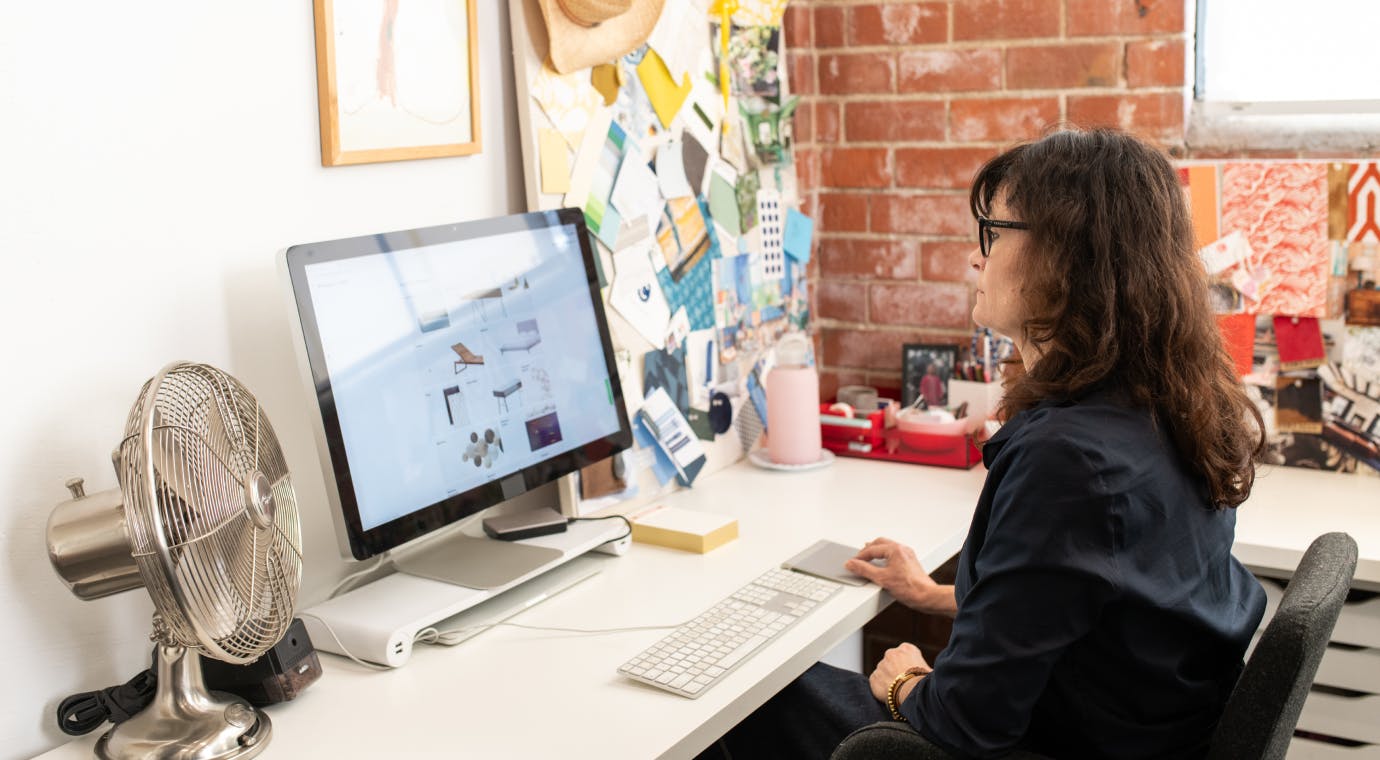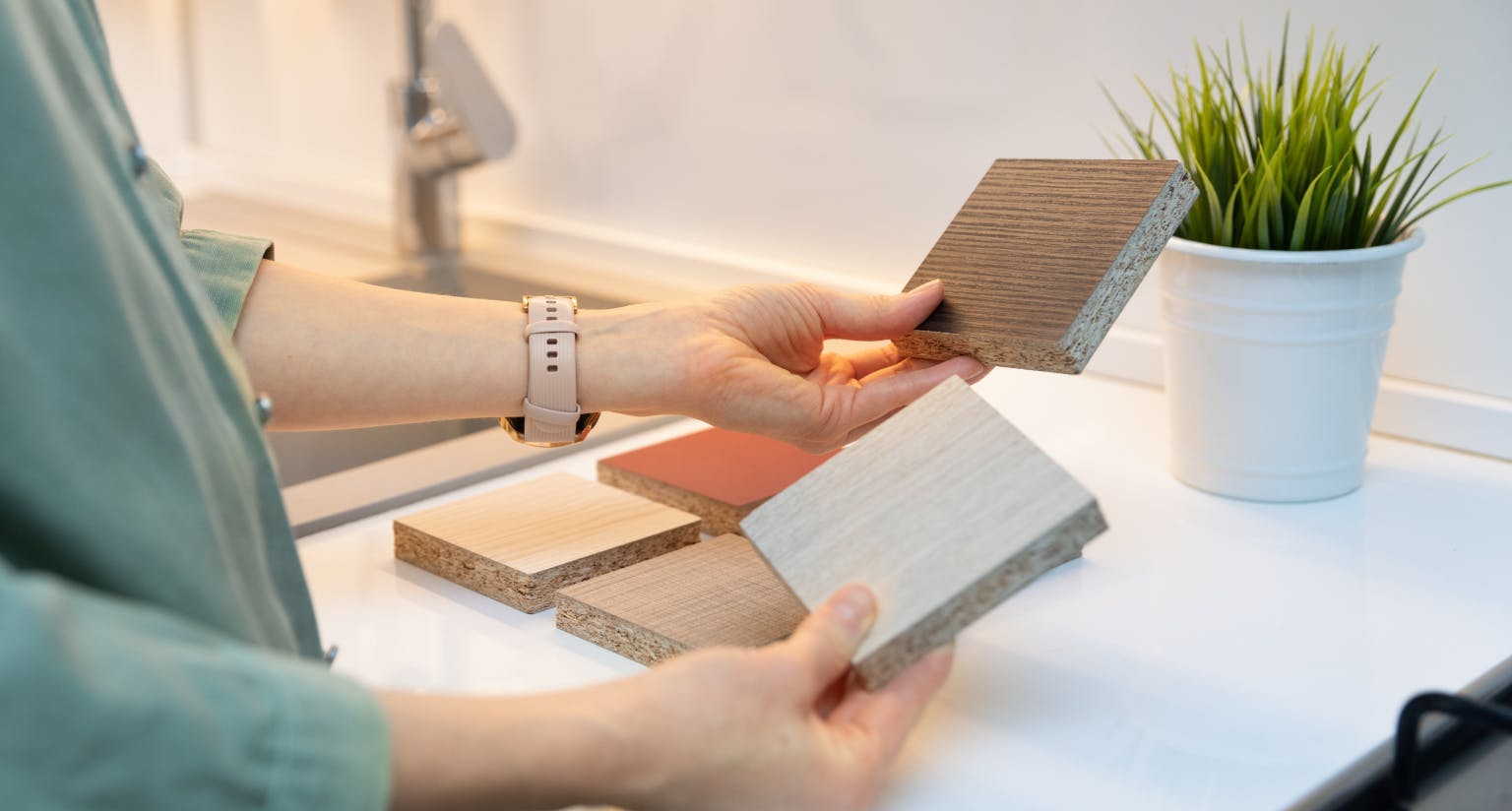The Complete Guide to Organising Interior Design Project Materials
Our Houzz Pro Learn guide will give you a comprehensive overview of how to organise your design materials for interior design projects

Organising materials, projects, and client files is an essential factor for a successful interior design business. While it can take time up front, having a well-structured organisation system in place can help your business be more efficient, enabling you to have more time to create stunning designs for clients. No more clutter distracting from your creativity, or wasting precious time searching to find the materials you need for your projects. With organised interior design materials, you’ll have everything where and when you need it.
You may not know, though, where to begin to create a really great organisational system, or you may not have the time to do the research and planning. Thankfully, we’ve done this part for you. In this Houzz Pro Learn guide, you’ll get an essential overview to help you start organising interior design materials for your business from scratch or learn great tips to help you reorganise your existing materials. Read on to learn more and start getting organised:
- Considerations for your interior design organisation system
- How to organise by interior design material
- Interior design organisation tools
- Organisation inspiration from real interior designers

Considerations for your interior design organisation system
When deciding how to organise interior design materials for your business, it’s important to remember that not one size fits all. The particular qualities of your business, the size of your workspace, specific interior design materials that you use, your clients, organisation style and systems are unique to you, so keep an open mind about adopting this guide to best suit your individual needs.
Size of workspace
The size of your workspace will be an important consideration for organising your interior design materials. If you have a smaller space, you may need to choose higher-density cabinets to store your materials or utilise the height of your space to store materials on taller bookshelves or hanging rods to access via a step ladder. If you have a larger space, you might want to dedicate a certain area for meeting with clients or for giving presentations. Just like with your own clients, consider the size of your space the starting point for visualising how you’ll organise your interior design materials.
Location of workspace
Many interior designers have their workspace in their homes. If this is your case, you already know the importance of keeping work materials and your home life separate. Do your best to make your workspace exclusively for work so that items from home don’t creep into it – and vice versa. This will help you stay better organised and able to focus on your important design projects and be able to relax more in your home after work.
Client presentations
If you give client presentations from your workspace, you’ll want to create a dedicated space for this. You may need a TV, projector, or whiteboard and a table to display your design project materials. If you have the room, you can keep this space for presentations only. But if workspace size is an issue, consider a space-saving solution like a wall-mounted folding table, a portable whiteboard that can be stored away, or a pull-down projector screen instead of a TV. If you go to your client’s homes or offices to conduct presentations, then you won’t need to consider these factors and will have more room for other materials and needs specific to you in your workspace.
Accessibility
Accessibility is another highly important consideration for organising your interior design materials. As a designer, you’ll want to easily grab your most recent or frequently used project materials, so you may want to set aside a unique space for just these items. You will also want to make sure that everything is properly labelled from the outside – bookshelf sections, binders, drawers, bins, etc. – so you can be guided to just the right section of your design materials library you need at any moment.
If suppliers visit your workspace, they will need to be able to quickly pull any out-of-date materials, so that you won’t accidentally incorporate these into current design projects when they are unavailable. Your labelling and organisation, then, will need to be both useful for you, but also accessible and understandable for outside suppliers, if this is the case for your business.
Need for mobility
Your mobility needs can also impact how to best organise your interior design materials. If your materials mainly stay in your workspace, then you won’t need to worry about carrying them around. But if you or your client need to be able to have materials at the job site, then you’ll want an easy way to transport them without falling apart. Avoid transporting materials in bags or in boxes that you can’t see through. Consider lightweight, transparent bins instead with internal organisers inside to keep materials separate. You can even line them if your materials are particularly fragile. Rolling suitcases with compartments and built-in organisers are also a good option for ease of transport and for keeping materials safe.

How do interior designers organise their materials?
The following section will introduce different ways to organise each of the interior design materials you may use in your business based on the material or sample type.
Fabric
Fabric books and memos are often organised by colour, supplier or performance level, but you can organise your library to fit your particular needs. For example, you may want to organise by style or price if that’s more suitable for your design process or business, or organise by multiple levels of categories. Categorising by colour as a top category and print as a subcategory (geometric, floral, striped, etc.) is just one of the many ways to simplify finding the right fabric sample when you need it.
Rugs & Carpets
When organising rug and carpet samples, you can organise by colour, type, price, size, print design, brand, or combination with multiple category levels. You may also want to keep high-performance samples or certain types together, such as having Berber carpet samples all in one place.
Paints
Paint samples are best organised by colour, but you can also organise by temperature (warm, cool, neutrals), or whichever subcategory you choose. Paint sample books, fan decks and product catalogues are easily organised alphabetically by the supplier. You can also mark your books, decks and product catalogue pages with sticky tabs for certain products you like.
Wallpaper
Much like fabric, wallpaper is best organised by colour or supplier, but organising by print may also be good to consider.
Wood
Wood samples can be organised by type (oak, maple, cherry, etc.), from light to dark, by price or supplier, depending on your needs.
Metal
Metal is best organised by finish type: chrome, copper, brass, nickel, polished gold, etc.
Tile
You can organise tile samples by type (ceramic, porcelain, glass, marble, granite, etc.), and then sub-categorise by size and price for easier grouping.
Stone & Quartz
Like tile, stone and quartz can also be categorised by type, size and price or grouped into subcategories that are best for you.
Tools to organise interior design projects
When it comes to organising interior design materials in your workspace, there are a wide range of tools, storage and organisation solutions to choose from based on the material or sample type. Each option also has a variety of styles, sizes, and durability that best fit the needs of your interior design business, specific materials, and workspace. The following will explain some of the best tools and solutions for organising the interior design materials and samples you may use in your business.
Labels
It’s helpful to look at the interior design materials and samples in your workspace like a library. And while we don’t recommend replicating the Dewey Decimal System, properly labelling your materials and bins will be essential to organise your interior design materials. Quality label makers can be found at your local craft store and are highly recommended to have on hand at all times in your workspace.
Make sure to label the outside of your storage units, cabinets, boxes, and drawers, as well as the materials and samples themselves – if they didn’t come with a label already – so that nothing gets lost and items can easily be identified and ordered for your design projects. As a rule, it’s best to label everything, otherwise, it can’t be easily looked up later for sizing and ordering. This will save you time and money in the long run.
Trays
Trays are a great way to display your materials for client presentations or bring them to your desk or work table when you’re drawing out your design plans. Also, consider investing in a portable tray cabinet for great storage and accessibility where trays can be easily removed and then stored when not in use.
Bookshelves, books and binders
Wallpaper and paint sample books, paint fan decks, and product catalogues for materials can all be stored on bookshelves, which makes them easy to see and review for your interior design projects. You can group samples together as needed in binders or file holders and label your bookshelf in sections, much like you’d see in a library.
Organising interior design client files is best done in binders or file folders that can be stored neatly in a filing cabinet and organised alphabetically by the client. Within your binder or file section for your client, you will want to subcategorise further by client information and proposal, product specifications and product quotes, rendered designs or mood boards, space measurements and floor plans, contracts and invoices. If you have multiple projects for one client, you’ll want to keep each project separate from one another in your filing.
Cabinets, drawers and bins
Higher-density storage solutions such as flat files and paper storage cabinets are great space savers and also keep your materials out of sight, if you prefer having more of a “blank canvas” or minimalistic feel to your interior design workspace.
Floor coverings and countertop materials such as wood, tile, stone, quartz, carpet and rug samples tend to be a bit heavier than fabric samples, so these are often best stored in more durable drawers and cabinets, with varying options available. Whichever storage option you choose, make sure the samples will stay well-organised, particularly in drawers, either in small boxes or dividers. Because some of these materials are breakable, you may want to add protective drawer liners to your drawers, cabinets, or shelves.
Interior designers are visual, hands-on people. Having project bins to keep selected samples and materials for clients, can help keep your projects easily tactile, visible, and organised. Consider having one cabinet or cupboard storage exclusively for organising interior design projects for your active clients, so that all the samples and materials you’re using are all in one place.
Hanging rods
Hanging fabric books and memos is the best option for organising these interior design materials and is a great space saver for your workspace.
Digital product library
Having a digital product library is another essential for your interior design business where you can quickly and easily save and store the items you’ll be ordering for your client projects on the web within your own digital database.
Houzz Pro features a product library and a clipper tool that expedites product sourcing and helps to keep projects organised digitally. With so many moving parts to organising interior design materials, projects, and client files, it’s important to have a system to keep it all together. That’s where having the right software can really help. From creating mood boards and 3D designs, sourcing materials and products, to project management and invoicing, Houzz Pro is a great solution to help you manage your business and stay organised.

Organisation inspiration from real interior designers
On Fabric Samples
A Houzz Pro interior designer shares a great example of how their office approaches organising fabric sample books: “We hang our fabric books so we can flip through them as needed…it’s easy to unhook the ones we need. I had the maple ‘bookcases’ custom built (and they’re tapered). My carpenter attached the chrome closet rods and holders at varying heights based on the different book sizes. We use the simple stainless circle shower curtain rings to hang the books by their cord handles.”
On Client Files
Another designer has a very useful storage solution when working on active client projects: “During projects, I use these scrapbook cases. They stack on top of each other, latch closed, have a handle, and fit a paint deck or two perfectly! They are great because they keep all of the samples neat, organised, in good condition, and out of my bag. File folders fit perfectly as well.”
On Workspacing From Home
And an interior designer who works from home, shares this about the workspace: “At first my office was a small room in our house with samples overflowing into our dining room and garage. Now, my studio is a work in progress and is not styled or finished. A simple bookshelf houses all of our fabric swatches, tile samples, rug samples, etc. Our large table is where we host meetings and work daily. I use my row of cupboards and long countertop to hold pretty much everything else, such as job binders, cabinet samples, countertop samples, exterior samples and more.”
Conclusion
Organising your interior design materials and all you need for your business may seem daunting at first, but it’s a crucial undertaking for your success. Having a well-organised workspace, files, and digital product library will allow you to quickly find the materials you need, arrange and keep track of important project details, and more easily manage client files and the essentials of your business. With a strategic organisation system in place, you’ll be able to stay more focused on doing what you love: creating beautiful spaces for your interior design clients, without all the clutter or distractions.
Sign up for a free trial of Houzz Pro to explore our mood board, clipper tool and proposal features – all of which can help organise interior design materials.




